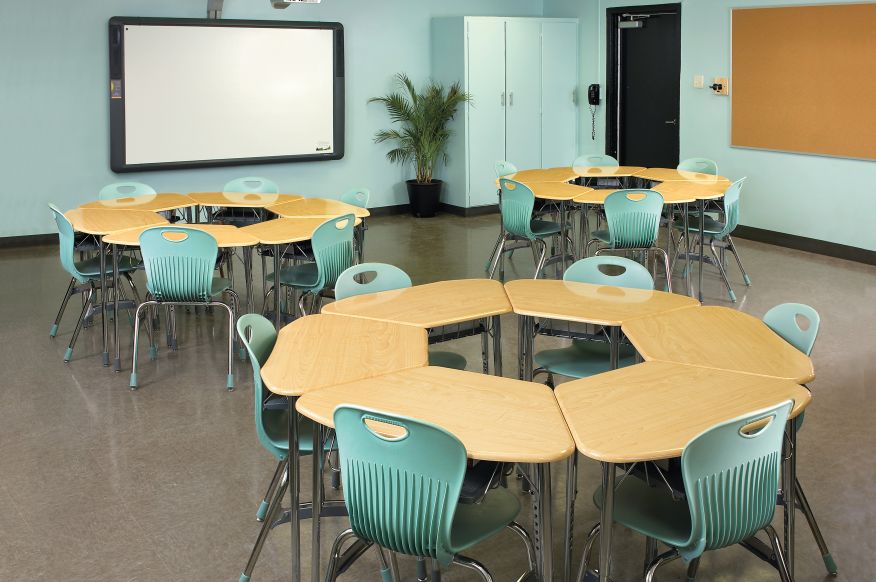(单词翻译:单击)
听力文本
Educators, Designers Look to Change Traditional Classroom Furniture
For much of the past hundred years, classrooms have been designed with the teacher seated in front of desks for students. The desks are almost always positioned in lines facing the teacher.
But many educators now say children can do better in a less structured learning environment. And designers have been providing spaces and seating to meet those suggestions.
Bob Pearlman works as an education consultant in the United States. He helps teachers and school administrators with educational planning and other issues. He told The Associated Press that traditional classrooms are a thing of the past. Now students work in "extended learning areas" that include project-planning rooms, workrooms, and laboratories, as well as learning spaces for groups and individuals.
Pearlman points to Albemarle County Public Schools, in Charlottesville, Virginia. The school system invited teams from all its schools to develop learning spaces that would help students deal with complex ideas and work on creative building projects. Now, its elementary school classes have exchanged traditional desks for things like soft seating and connectable tables.
Another change to the design of classrooms is the ability to connect to the internet.
"Classrooms, libraries, and [laboratories] used to be the only spaces where students spent their school hours. Wireless, laptops and project learning have changed that," Pearlman said. He noted that this has made all school spaces into possible extended learning areas.
Jo Earp is with Teacher magazine, a publication of the nonprofit Australian Council for Educational Research. She notes that in the 1970s, American Robert Sommer was urging a critical look at traditional classroom designs. Sommer was a psychologist. He believed that in any given room, the lighting or heating will be better in some places than in others.
Earp said that in addition to newer "freeform" classroom designs, some teachers can find good results with designs that combine new and old ideas.
They could try lining up desks at the start of the year and then placing them in groups as the classroom relationships become clearer and project work begins.
Natural light, reduced outside noise and good air quality are all considerations in classroom design, says Aaron Jobson. He is with the Quattrocchi Kwok Architects in Santa Rosa, California.
"More and more evidence connects the physical environment to learning outcomes," Jobson said.

New designs include glass walls inside buildings and doors that increase connectedness among students and create more open space for teachers.
A major supporter of nontraditional, explorative learning spaces is David Thornburg, who wrote the book "From the Campfire to the Holodeck." He says schools should provide spaces based on how humans learn. That could mean one room is used in different ways at different times, or in different ways at the same time.
Loren Myers teaches at a public charter school in San Jose, California. She says redesigning traditional schools can be costly, and teachers do not have big budgets. So she noted that many teachers get creative with what little money they have to create a specially designed classroom.
In her class, Myers set up a space where students can calm down and a special workplace for students who demonstrate good behavior.
Over the years, famous designers have lent their abilities to school furniture — among them, Jean Prouve, Alvar Aalto and Arne Jacobsen. Today, classroom furniture includes all kinds of seating, with work tables of different heights.
Imagine Charter Schools, which operates schools in nine U.S. states, offers colorful seating that turns in different directions and other soft seating. Montessori schools have soft lighting similar to home environments, and simpler furniture than traditional classrooms.
Marianne Box is a design specialist at school-furniture maker Hertz Furniture, in Ramsey, New Jersey. She says movable pieces are big sellers at the company. They are designed to help control children's energy levels, and give them places to center their attention.
Self-contained study areas have power supplies for computers, footrests and armrests.
Teacher Loren Myers loves that designers are coming up with more seating choices for young students.
"Children shouldn't be expected to sit still in a chair for more than 20 minutes at a time," she says. "Sometimes it's as simple as switching where and how you sit that can set the tone for the rest of your day."
重点解析
重点讲解:
1. in front of 在......前面;在......面前;
I stood for a few moments in front of the nearest shop window.
我在最近的一家商店的橱窗前站了一会儿。
2. as well as 也;既......又;
It is in his best interests as well as yours.
这符合他的最大利益,同时也符合你的利益。
3. line up 排队;排成一行;
I would line up my toys on this windowsill and play.
我会把玩具排在这个窗台上来玩。
4. similar to 相似;与......类似;
My opinions are similar to his.
她在东京长大。
参考译文
教育工作者和设计师希望改变传统的教室设备
在过去几百年的时间里,教室的设计一直是学生有自己的课桌,而老师则坐在所有学生的前面。课桌几乎总是排成几行,面对着老师。
但许多教育工作者现在表示,孩子们在结构化不太强的的学习环境中会学得更好。设计师一直在为教室提供空间和座位,以满足这些建议。
鲍勃·皮尔曼是一位美国教育顾问,他帮助教师和学校管理者制定教育规划和其他事宜。他告诉美联社,传统的教室已经成为过去。现在,学生在“扩展的学习区域”中学习,包括项目规划室、工作室和实验室,以及为小组和个人提供的学习空间。
皮尔曼提到了弗吉尼亚州夏洛茨维尔市阿尔伯马尔县的公立学校,公立学校系统邀请所有学校的团队,一道开发学习空间,帮助学生处理复杂的想法,并实施创造性的建设项目。现在,学校体系中的小学课堂中已经换掉了传统的课桌,取而代之的是沙发和相互连接的课桌。
教室设计中的另一个变化是连接到互联网的能力。
皮尔曼说:“教室、图书馆和[实验室]曾经是学生们在学校里唯一能去的几个地方。而无线网络、笔记本电脑和项目学习改变了这一点”。他指出,这使所有的学校空间都可能扩展为学习区域。
乔·厄普是《教师杂志》的撰稿人,该杂志是一家非营利性的澳大利亚教育研究委员会的出版物。她表示,在20世纪70年代,美国人罗伯特·索默力劝人们利用批判性的眼光,审视传统的课堂设计。索默是一位心理学家。他相信在任何房间里,某些地方的照明或供暖总会比其他地方好。
计外,一些教师还能通过结合新旧观念的设计获得良好的教学效果。
他们尝试在年初时,把课桌按排码放。随着课堂关系变得更加清晰,项目工作开始后,就可以把课桌分组码放。
“自然光、减少外部噪音,以及良好的空气质量都是课堂设计需要考虑的因素,”就职于加利福尼亚州圣罗莎的夸特罗奇·郭克建筑师事务所的亚伦·约布森说道。
“越来越多的证据将物理环境与学习成果联系起来,” 约布森说。
新设计包括建筑内的玻璃墙和门,它们可以增强学生之间的联系,为教师创造更多的开放空间。
大卫·桑伯格是非传统探索性学习空间的主要支持者,他撰写了《从篝火到全息甲板》一书。他说学校应该根据人类的学习方式提供空间,这意味着一个房间在不同的时间可以有不同的用途,或者是在同一时间用作不同的用途。
洛伦·迈尔斯在加利福尼亚州圣何塞的一所特许公立学校任教,她说,重新设计传统学校的成本可能很高,教师也没有很大的预算。因此,她指出,许多教师只花了很少的钱就创造性的开发出一间专门设计的教室。
在她的课堂上,迈尔斯建立了一个可以让学生们安静下来的空间,以及一个为表彰学生良好行为的特殊地点。
多年来,著名的设计师致力于开发学校设备,其中包括让·普罗维、阿尔瓦·阿尔托和阿恩·雅各布森。今天,教室设备包括各种各样的座椅,以及不同高度的工作台。
想象一下,在美国九个州开办学校的特许学校,提供了可以转向不同方向的五颜六色的座位,还有其他沙发。蒙台梭利学校拥有与家庭环境相似的柔和灯光,和比传统教室更简单的设备。
玛丽安·博克斯是新泽西州拉姆齐市学校设备制造商赫兹家具公司的设计专家。她说,活动部件在公司很畅销。它们被设计用来控制儿童的精力水平,并给他们提供集中注意力的地方。
独立的学习区里配有电脑、脚踏板和座椅扶手的电源。
洛伦·迈尔斯老师喜欢设计师为年轻学生提供更多的座位选择。
她说:“孩子们不应该一次坐在椅子上超过20分钟。有时候,只需要改变坐的位置和坐姿,就能为你一天中的其他时间设定基调。”
译文为可可英语翻译,未经授权请勿转载!


